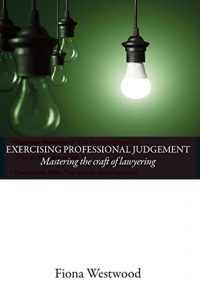‘This is the fourth in my series of books about professionals and their practice. It investigates the importance of learning from work-based experiences in a supportive ‘community of practice’ that encourages reflection. It concentrates on the exercise of professional judgement in the context of mastering the craft of lawyering. I feel that this is especially important at this point in time when current changes in the way legal services are delivered may put at risk the traditional method the legal profession has used to develop this in its new entrants.
Everyone involved in the UK legal profession is well aware of recent changes to its structure and methods of working. The opening up of the legal services market to ‘alternative business structures’ following the Legal Services Act 2007 has created a variety of delivery mechanisms, ranging from acquisitions of indigenous law firms by other jurisdictions to new corporate entrants adding legal advice to their existing ‘products’. Adjustments to fee levels and work practices mean that some are concentrating on specialist advice while others are employing para-legals to complete work on ‘commoditised’ client files. Whether these responses will achieve the government-commissioned Clementi Report’s (Clementi 2004) aim of improving the quality of the provision of legal services remains to be seen. Some incomers have already found it more difficult than they anticipated to operate profitably and have withdrawn from the market. However, the overall effect has been to fragment what, up until 2007, had been a fairly cohesive profession.
Regardless of all of this, clients continue to expect their legal advisors to provide them with solutions to their problems and where needed, access to justice. To achieve this, given the complexities of what is involved in the application of the relevant law to the particular situations clients find themselves in, lawyers have to exercise their professional judgement so as to determine what options are available and, most importantly, achievable. Traditionally, they have developed the ability to do this through induction to and subsequent experience in a ‘community of practice’ where more senior practitioners allocate tasks to and supervise novices as well as share with them the way they arrive at and implement the most appropriate choice available in the specific set of circumstances. However, recent alterations in work practices brought about, in particular, by information technology have reduced the availability of the type of low-risk routine work usually completed by trainees to allow them to gain experience and proficiency.
So this book is about identifying how lawyers, up to this point in time, have developed their judgement and, through recognising the changes affecting their profession, offering a model that will continue to allow new entrants to achieve this, regardless of the type of legal services providers they work in. In addition, given that external influences, including IT and pressures on profits are being felt by many professions, I hope that the Model will also be relevant to other disciplines where the training of novices has to be embedded in organisations that need to match their people and resources with the management of risk, client satisfaction and quality of services.
Everyone involved in the UK legal profession is well aware of recent changes to its structure and methods of working. The opening up of the legal services market to ‘alternative business structures’ following the Legal Services Act 2007 has created a variety of delivery mechanisms, ranging from acquisitions of indigenous law firms by other jurisdictions to new corporate entrants adding legal advice to their existing ‘products’. Adjustments to fee levels and work practices mean that some are concentrating on specialist advice while others are employing para-legals to complete work on ‘commoditised’ client files. Whether these responses will achieve the government-commissioned Clementi Report’s (Clementi 2004) aim of improving the quality of the provision of legal services remains to be seen. Some incomers have already found it more difficult than they anticipated to operate profitably and have withdrawn from the market. However, the overall effect has been to fragment what, up until 2007, had been a fairly cohesive profession.
Regardless of all of this, clients continue to expect their legal advisors to provide them with solutions to their problems and where needed, access to justice. To achieve this, given the complexities of what is involved in the application of the relevant law to the particular situations clients find themselves in, lawyers have to exercise their professional judgement so as to determine what options are available and, most importantly, achievable. Traditionally, they have developed the ability to do this through induction to and subsequent experience in a ‘community of practice’ where more senior practitioners allocate tasks to and supervise novices as well as share with them the way they arrive at and implement the most appropriate choice available in the specific set of circumstances. However, recent alterations in work practices brought about, in particular, by information technology have reduced the availability of the type of low-risk routine work usually completed by trainees to allow them to gain experience and proficiency.
So this book is about identifying how lawyers, up to this point in time, have developed their judgement and, through recognising the changes affecting their profession, offering a model that will continue to allow new entrants to achieve this, regardless of the type of legal services providers they work in. In addition, given that external influences, including IT and pressures on profits are being felt by many professions, I hope that the Model will also be relevant to other disciplines where the training of novices has to be embedded in organisations that need to match their people and resources with the management of risk, client satisfaction and quality of services.












